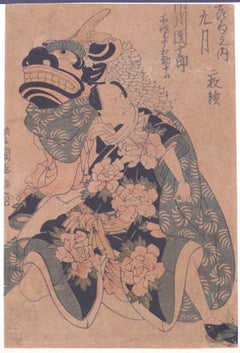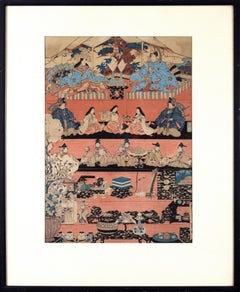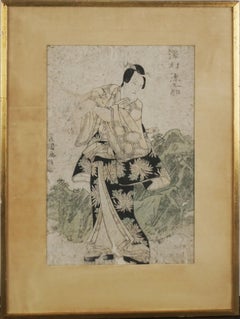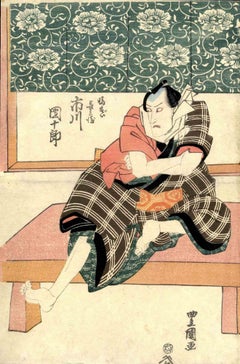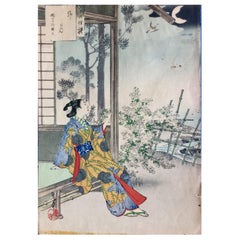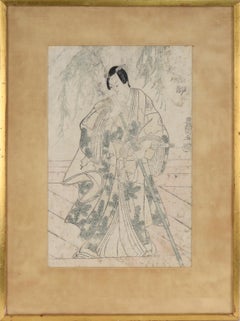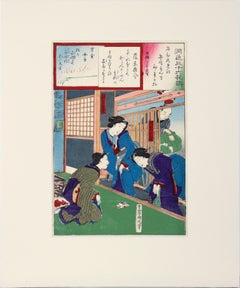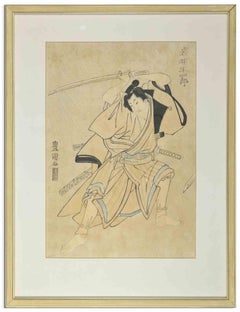Utagawa Toyokuni Art
Japanese, 1769-1825
Utagawa Toyokuni[a] (歌川 豊国; 1769 – 24 February 1825), also often referred to as Toyokuni I, to distinguish him from the members of his school who took over his gō (art-name) after he died, was a great master of ukiyo-e, known in particular for his kabuki actor prints. He was the second head of the renowned Utagawa school of Japanese woodblock artists, and was the artist who elevated it to the position of great fame and power it occupied for the rest of the nineteenth century.
He was born, the son of Kurahashi Gorobei, a carver of dolls and puppets, including replicas of kabuki actors.
At around 14, Toyokuni was apprenticed to the first head of the Utagawa house, Utagawa Toyoharu, whom his father knew well and who lived nearby.
One of his fellow pupils under Toyoharu was Toyohiro, whose pupil was the great landscape artist Hiroshige. In recognition of his artistic ability, Toyokuni later took the name Utagawa Toyokuni, following the common practice of using one syllable of his master's name.
Toyokuni seems not to have been an "intuitive genius"determined to forge a new path; rather, he seems to have studied intently those who came before him, particularly Utamaro, Chōbunsai Eishi and Eishōsai Chōki and through a great deal of hard work produced first a mastery, and then a synthesis of their styles, to create a style of his own.
He was known mostly for his prints related to the kabuki theatre, in particular his yakusha-e actor portraits, a field which he took to new heights. He also, however, produced other genres such as musha-e warrior prints, shunga erotica, and most notably bijin-ga.
In his actor prints, like Sharaku, one sees the real subject; but his prints merely portrayed what he saw, unlike Sharaku who exaggerated those aspects he saw as the most key. It is said of Toyokuni's prints that they recreate exactly what one would see on stage; they show actors acting, not merely just pictures of actors.
Together, these characteristics made Toyokuni's prints far more popular among theatre-goers than Sharaku's, although history has come to judge Sharaku the keener observer and greater artist.
His popularity and prolific output may in part have been his undoing, though. From 1803 through 1817, his work became more static, even as it became more popular. He continued to produce large quantities of prints, but the quality as a rule did not match that of his earlier days. Occasional prints from this period, however, show his old brillianceto
3
6
2
1
Overall Width
to
Overall Height
to
9
3
1
1
7
2
9
6
6
5
3
3
3
3
2
1
1
1
1
8
5
3
3
3
11
10,138
2,778
1,375
1,370
3
3
4
2
Artist: Utagawa Toyokuni
Man with the Dragon - Woodblock Print by Utagawa Toyokuni I - 1800 ca
By Utagawa Toyokuni
Located in Roma, IT
Man with the Dragon is a superb color woodbloock print on rice-paper, realized by the great master of ukiyo-e print, Utagawa Toyokuni I (1769-1825)
Depicti...
Category
Early 1800s Utagawa Toyokuni Art
Materials
Paper, Woodcut
"Various Himochi" Wagashi Festival Japanese Woodblock Print by Utagawa Toyokuni
By Utagawa Toyokuni
Located in Soquel, CA
"Various Himochi" Wagashi Festival Japanese Woodblock Print by Utagawa Toyokuni
Rare oversized early 19th century 5-tiered woodblock by Utagawa Ichiyosai Toyokuni, (Japan, 1769-1825), a Japanese lord and wife oversee a sekku festival of food, music, and dolls or toys. '"oshi" is the first day of “Mi (Snake)” in the third month of the lunar calendar. This day, known in modern Japan as the Girls' Festival, originated in China as a form of purification ceremony in which water and drinking peach blossom wine were used to drive away evil. Many kinds of hishi-mochi appear in this picture of hina ningyo (dolls associated with Hinamatsuri, or the Girl’s Day) from Omochae.
The custom of eating special dishes at events throughout the year and at milestones in people's lives has existed since ancient times. This paragraph specifically focuses on the annual event called sekku, and life events that involve eating sweets. Joshi is the first day of “Mi (Snake)” in the third month of the lunar calendar. This day, known in modern Japan as the Girls' Festival, originated in China as a form of purification ceremony in which water and drinking peach blossom wine were used to drive away evil. According to the Keiso saijiki, in ancient China, on the third day of the third lunar month, people ate “ryuzetsuhan,” which is the juice of gogyo (Jersey cudweed) mixed with rice flour and nectar. In Japan, there is a record in the Heian period history book Nihon Montoku tenno jitsuroku [839-5] that it was an annual event to make kusamochi using gogyo on the third day of the third month of the lunar calendar, which may have been influenced by Chinese customs.
The tradition of eating kusamochi on the third day of the third month of the lunar calendar continued after that. By the Edo period, however, hishimochi had come to be used as a sweet to serve on the third day of the third month. A picture of a hishimochi is included in the Morisada manko , which we mentioned in Part 1. According to it, hishimochi in the Edo period were often three layers of green-white-green instead of the now common red-white-green. However, it is possible to see from our collection that not all hishimochi were made in this way. Omochae published in 1857, is a good example. Omochae is a type of ukiyoe print...
Category
1820s Edo Utagawa Toyokuni Art
Materials
Ink, Rice Paper, Woodcut
Kabuki Actor in Water Lily Robe with Samurai Sword - Japanese Woodblock Print
By Utagawa Toyokuni
Located in Soquel, CA
Kabuki Actor in Water Lily Robe with Samurai Sword- Japanese Woodblock Print
Finely detailed woodblock by Utagawa Toyokuni (Japanese, 1769-1825). A kabuki actor ("Master Haranyuki Sawamura") is standing on stage with mountainous backdrop, wearing a robe in a water lily pattern. He is wearing a samurai sword.
Presented in a gold colored frame with a silk mat.
Frame size: 20"H x 14.25"W
Image size: 14"H x 9"W
Utagawa Toyokuni (Japanese, 1769-1825) was born in Edo, the son of Kurahashi Gorobei, a carver of dolls and puppets...
Category
Early 19th Century Edo Utagawa Toyokuni Art
Materials
Ink, Rice Paper, Woodcut
Ichikawa Danjuro in the Role of Chobei - Woodcut by Utagawa Toyokuni - 1810s
By Utagawa Toyokuni
Located in Roma, IT
Ichikawa Danjuro in the role of Chobei is an original modern artwork realized by Utagawa Toyokuni (Edo, 1769 – Edo, 1825).
Original Woodcut Print.
Oban from a Triptych, around 1810.
The actor Ichikawa Danjuro sitting on a bench and fretting, behind him a green curtain with peony motif.
Signed: Toyokuni ga. Publisher: Yamamotoya Heikichi.
Excellent impression, cut, centrefold, a little bit rubbed and soiled.
Utagawa Toyokuni (Edo, 1769 – Edo, 1825), also often referred to as Toyokuni I...
Category
1810s Modern Utagawa Toyokuni Art
Materials
Woodcut
Set of Eight Period Japanese Colored Woodblock Print
By Utagawa Toyokuni
Located in Roma, IT
Important series of eight colorful Japanese woodblock prints featuring iconic scenes of Japanese life.
They are the work of great artists including:
Mizuno Toshikata (1866-1908)
Utagawa Toyokuni (Japanese: ?; 1769 in Edo – 24 February 1825 in Edo)
This series of woodblock prints, never before on the market, comes from a private collection.
Utagawa Toyokuni[a] (歌川 豊国; 1769 – 24 February 1825), also often referred to as Toyokuni I, to distinguish him from the members of his school who took over his gō (art-name) after he died, was a great master of ukiyo-e, known in particular for his kabuki actor prints.
He was the second head of the renowned Utagawa school of Japanese woodblock artists, and was the artist who elevated it to the position of great fame and power it occupied for the rest of the nineteenth century.
He was born, the son of Kurahashi Gorobei, a carver of dolls and puppets...
Category
Late 19th Century Old Masters Utagawa Toyokuni Art
Materials
Paper, Lithograph
Kabuki Actor with Pine-Patterned Robe - Japanese Woodblock Print
By Utagawa Toyokuni
Located in Soquel, CA
Kabuki Actor with Pine-Patterned Robe - Japanese Woodblock Print
Finely detailed woodblock by Utagawa Toyokuni (Japanese, 1769-1825). A kabuki actor is standing on a wooden deck, wearing a robe with a pine-needle pattern. He is holding a sword and a staff. In the background, tree branches hang down from out of frame.
Presented in a gold colored frame with a silk mat.
Frame size: 20"H x 14.25"W
Image size: 14"H x 8.5"W
Utagawa Toyokuni (Japanese, 1769-1825) was born in Edo, the son of Kurahashi Gorobei, a carver of dolls and puppets...
Category
Early 19th Century Impressionist Utagawa Toyokuni Art
Materials
Ink, Rice Paper, Woodcut
Nakamura Daikichi - Woodcut Print by Utagawa Toyokuni - 1820s
By Utagawa Toyokuni
Located in Roma, IT
Nakamura Daikichi and Seki Sanjuro is an original modern artwork realized by Utagawa Toyokuni I in 1820-30.
Woodcut Print Oban Dyptich Format
Nakamura Da...
Category
19th Century Modern Utagawa Toyokuni Art
Materials
Woodcut
Oriental Scene - Woodcut Print by Utagawa Toyokuni - 1820s
By Utagawa Toyokuni
Located in Roma, IT
Oriental scene is an original modern artwork realized by Toyoukuni I in 1820-30.
Woodcut Print Oban Format
Scene on the veranda of a restaurant overlooking a bay with ships. Seki S...
Category
19th Century Modern Utagawa Toyokuni Art
Materials
Woodcut
Inari Kozo Tasaburo- Kabuki
By Utagawa Toyokuni
Located in Fairlawn, OH
Inari Kozo Tasaburo- Kabuki
Color woodcut, c. 1820
Signed: ‘Toyokuni’
Publisher: ‘Yamamoto Heikichi’
Censor: Hama and Magome
Very good impression and color
Sheet/Image size: 15 1/2 x...
Category
1820s Other Art Style Utagawa Toyokuni Art
Materials
Woodcut
Related Items
"Fanti Fishing Boat" Modern Abstract Figurative Woodcut Print 47 of 86
By John Thomas Biggers
Located in Houston, TX
Abstract figurative woodblock print of a beach landscape with a boat. The print is stamped by the artist and titled and editioned in pencil. This print is editioned 47 of 86 and the print is not currently framed.
Artist Biography: Born in Gastonia, North Carolina in 1924, John Biggers studied at Hampton Institute (now Hampton University) under Viktor Lowenfeld and muralist Charles White. In 1943, Biggers' mural, Dying Soldier, was included in the exhibition curated by Lowenfeld, Young Negro Art, at the Museum of Modern Art in New York.
After serving in the United States Navy, Biggers transferred to Pennsylvania State University where he earned his bachelor’s and master’s degrees as well as his doctorate in art education. In 1949, Biggers accepted a faculty position at Texas State University for Negroes (now Texas Southern University) in Houston, where he founded and chaired the art department until his retirement. In the early 50s, he won prizes for his work at annual exhibitions held at the Museum of Fine Arts, Houston and the Dallas Museum of Art.
In 1957, he traveled to Africa on a UNESCO fellowship to study Western African cultural traditions, becoming one of the first black artists to study the culture first-hand rather than through library research. His work was profoundly influenced by his experiences in Africa.
He was known for his murals, but also for his drawings, paintings, and lithographs, and was honored by a major traveling retrospective exhibition from 1995 to 1997. He created archetypal imagery that spoke positively to the rich and varied ethnic heritage of African Americans, long before the Civil Rights era drew...
Category
Late 20th Century Modern Utagawa Toyokuni Art
Materials
Woodcut
$1,500
H 14.75 in W 19 in D 0.04 in
"Enshoku Sanju-roku Kasen" (Thirty-six Enchanting Flowers) Woodblock on paper
By Toyohara Kunichika
Located in Soquel, CA
"Enshoku Sanju-roku Kasen" (Thirty-six Enchanting Flowers) Woodblock on paper
Elegant woodblock print by Toyohara Kunuchika (Japanese, 1835-1900). Three women are in talking with each other inside, while a man waits outside holding a bag of some kind. The colors in this piece are rich and saturated, primarily blues, greens, and purple.
Mat size: 16"H x 20"W
Paper size: 14.75"H x 9.88"W
Born in 1835, Toyohara Kunichika grew up in the Kyobashi district of Edo in the midst of merchants and artisans. In 1848, at age 13, he was accepted as an apprentice into the studio of Utagawa Kunisada I...
Category
1880s Edo Utagawa Toyokuni Art
Materials
Ink, Rice Paper, Woodcut
$380 Sale Price
20% Off
H 20 in W 16 in D 0.25 in
Two Kabuki Actors Japanese Woodblock Print
By Toyohara Kunichika
Located in Houston, TX
Two kabuki actors posing a samurai's. The print is printed on rice paper and is not framed. It is stamped by the artist with details about the actors in ...
Category
1860s Edo Utagawa Toyokuni Art
Materials
Woodcut
"Toy Horse Dance" Japanese Woodblock Triptych with Beauties and Mt Fuji
Located in Soquel, CA
"Toy Horse Dance" Japanese Woodblock Triptych with Beauties and Mt Fuji
Vibrant three-panel woodblock print by Utagawa Toyohiro (Japanese,...
Category
Early 20th Century Edo Utagawa Toyokuni Art
Materials
Ink, Rice Paper, Woodcut
Utagawa Toyohiro"Toy Horse Dance" Japanese Woodblock Triptych with Beauties and Mt Fuji, early 1900s
$1,360 Sale Price
20% Off
H 24 in W 36 in D 0.25 in
"Thirsty: the appearance of a town geisha in the Ansei era" - Woodblock on Paper
By Tsukioka Yoshitoshi
Located in Soquel, CA
"Thirsty: the appearance of a town geisha in the Ansei era" - Woodblock on Paper
From the series "Thirty-two Aspects of Customs and Manners" (Fuzoku sanjuniso)
Lively woodblock of a...
Category
1880s Edo Utagawa Toyokuni Art
Materials
Paper, Ink, Woodcut
$760 Sale Price
20% Off
H 20 in W 14 in D 0.75 in
Apollo, plate 11 from the series of The Gods in Niches
Located in Middletown, NY
by Jacopo Caraglio (after Rosso Fiorentino)
Rome: Carlo Losi, 1526. Engraving on cream laid paper, 8 1/2 x 4 3/8 inches, 215 x 110 mm), thread margins. In very good condition with a...
Category
17th Century Old Masters Utagawa Toyokuni Art
Materials
Laid Paper, Handmade Paper, Engraving
Edo Landscape Japanese Woodblock Print
By Utagawa Hiroshige (Ando Hiroshige)
Located in Houston, TX
Edo Meisho woodblock print of a famous Japanese coastal dock. This woodblock is most likely apart of the series "One Hundred Famous Views of Edo." The woodblock print is printed on r...
Category
1850s Edo Utagawa Toyokuni Art
Materials
Woodcut
$1,500
H 10 in W 15 in D 0.004 in
Japanese Beauties Enjoy a Full Moon
By Utagawa Kunisada (Toyokuni III)
Located in Burbank, CA
"Sun, Moon and Stars". Three beauties enjoy a full moon on the veranda of a teahouse or restuarant. The woman on the left kneels and adjusts her lavishly printed kimono. The beauty in the center has her hair down, and behind her is a screen against which shadows are beautifully silhouetted, which adds an air of mystery. The seated woman on the right is perhaps a geisha, as we see a shamisen lying next to her. Before her is a tray with an assortment of foods. One may surmise that the beauties are being compared to the sun, the moon, and the stars. On the left we glimpse a full moon shining over the peaceful bay, and boats at harbor. Original first edition Japanese color woodblock print triptych...
Category
1840s Edo Utagawa Toyokuni Art
Materials
Woodcut, Mulberry Paper
$2,880 Sale Price
20% Off
H 14.18 in W 29.06 in
Schwarze Madonna
Located in Wien, 9
Auguste Kronheim was born in Amsterdam in 1937. The artist makes woodcuts and drawings. She received her training in drawing from Hanns Kobinger and graduated from the Linz Federal T...
Category
20th Century Modern Utagawa Toyokuni Art
Materials
Woodcut
Tolosa (Toulouse); Leaf LXXI from Hartmann Schedel's Nuremberg Chronicle
Located in Middletown, NY
Woodcut on laid paper, 8 3/8 x 9 1/8 inches (212 x 233 mm), the full sheet. In excellent condition with text and portraits of Empedocles, Sapho, Zeuxis and others on the verso, as is...
Category
15th Century and Earlier Old Masters Utagawa Toyokuni Art
Materials
Ink, Handmade Paper, Laid Paper, Woodcut
New York Skyline
By Louis H. Ruyl
Located in Middletown, NY
Etching with drypoint on cream wove paper with deckle edges, 4 3/8 x 12 3/4 inches (233 x 323 mm); sheet 9 1/2 x 15 3/4 inches (240 x 338 mm), full margins. Signed and numbered 4/75 ...
Category
Early 20th Century American Modern Utagawa Toyokuni Art
Materials
Handmade Paper, Etching, Drypoint
Beggar man and woman coming from behind a bank – after Rembrandt van Rijn
By Charles Amand Durand
Located in Middletown, NY
Etching on cream laid paper laid down to a wove paper support, 4 x 2 5/8 inches (101 x 67 mm) (sheet). In good condition with scattered light areas of discoloration. Printed early 19...
Category
17th Century Old Masters Utagawa Toyokuni Art
Materials
Laid Paper, Etching
Previously Available Items
Actor Iwai Hanshiro as a Samurai by Utagawa Toyokuni I - Early 19th Century
By Utagawa Toyokuni
Located in Roma, IT
Actor Iwai Hanshiro as a Samurai is an artwork realized by Utagawa Toyokuni (1769-1825), in the early 19th Century
Color woodcut, signed or inscribed in the top right and bottom lef...
Category
Early 19th Century Modern Utagawa Toyokuni Art
Materials
Woodcut
H 19.3 in W 14.97 in D 0.04 in
Geisha - Original Woodcut Print by Toyokuni I - 19th Century
By Utagawa Toyokuni
Located in Roma, IT
This Ukiyo-e Print is a colored woodblock print on paper, realized by the Japanese old master, Utagawa Toyokuni, best-known as Toyokuni I (1769-1825), activ...
Category
19th Century Utagawa Toyokuni Art
Materials
Woodcut, Paper
H 14.38 in W 10.08 in D 0.04 in
Ichikawa Danjuro VII
By Utagawa Toyokuni
Located in Austin, TX
Artist: Utagawa Toyokuni I
Title: Ichikawa Danjuro VII
Medium: Color woodblock print
Origin: Japan
Date: 1786
Dimensions: 8.5 inches height x 7.5 in width
T...
Category
Late 18th Century Edo Utagawa Toyokuni Art
Materials
Woodcut
Three Beauties by a River Japanese Woodblock Print
By Utagawa Toyokuni
Located in Houston, TX
Japanese woodblock print of three beauties by a river. The work has some age to it. it is stamped by the artist. The woodblock print is printed on rice paper. The print is not framed.
Artist Biography: The son of a puppet sculptor, Toyokuni was born and worked in Edo. Entering the studio of Toyoharu at the age of 14, Toyokuni drew inspiration from the famous contemporary artists around him, particularly from the great Utamaro. Toyokuni produced elegant courtesans, fine actor prints...
Category
Late 18th Century Edo Utagawa Toyokuni Art
Materials
Woodcut
H 13.5 in W 9 in D 0.004 in
Utagawa Toyokuni art for sale on 1stDibs.
Find a wide variety of authentic Utagawa Toyokuni art available for sale on 1stDibs. You can also browse by medium to find art by Utagawa Toyokuni in woodcut print and more. Much of the original work by this artist or collective was created during the 19th century and is mostly associated with the modern style. Not every interior allows for large Utagawa Toyokuni art, so small editions measuring 9 inches across are available. Customers who are interested in this artist might also find the work of Lucien Métivet, Robert De Launay, and Frank Kleinholz. Utagawa Toyokuni art prices can differ depending upon medium, time period and other attributes. On 1stDibs, the price for these items starts at $627 and tops out at $719, while the average work can sell for $627.
